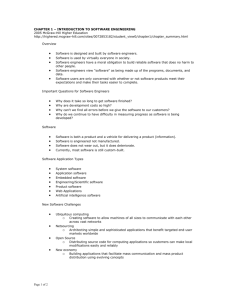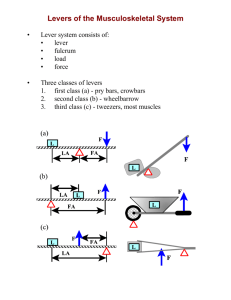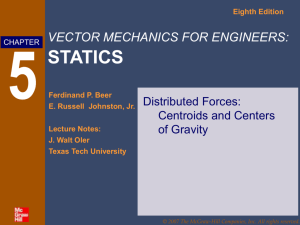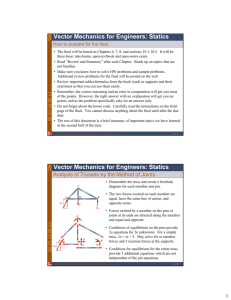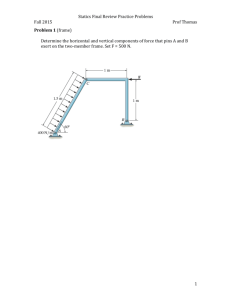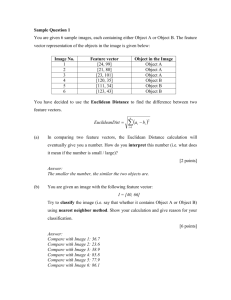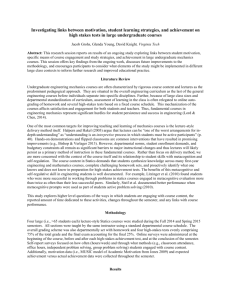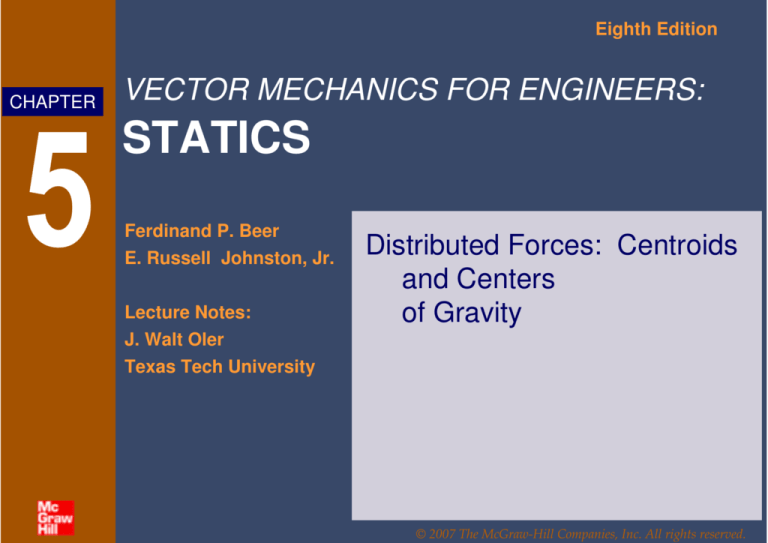
Eighth Edition
CHAPTER
5
VECTOR MECHANICS FOR ENGINEERS:
STATICS
Ferdinand P. Beer
E. Russell Johnston, Jr.
Lecture Notes:
Distributed Forces: Centroids
and Centers
of Gravity
J. Walt Oler
Texas Tech University
© 2007 The McGraw-Hill Companies, Inc. All rights reserved.
Eighth
Edition
Vector Mechanics for Engineers: Statics
Contents
Introduction
Theorems of Pappus-Guldinus
Center of Gravity of a 2D Body
Sample Problem 5.7
Centroids and First Moments of Areas
and Lines
Distributed Loads on Beams
Centroids of Common Shapes of Areas
Centroids of Common Shapes of Lines
Center of Gravity of a 3D Body:
Centroid of a Volume
Composite Plates and Areas
Centroids of Common 3D Shapes
Sample Problem 5.1
Composite 3D Bodies
Determination of Centroids by Integration
Sample Problem 5.12
Sample Problem 5.9
Sample Problem 5.4
© 2007 The McGraw-Hill Companies, Inc. All rights reserved.
5-2
Eighth
Edition
Vector Mechanics for Engineers: Statics
Introduction
• The earth exerts a gravitational force on each of the particles
forming a body. These forces can be replace by a single
equivalent force equal to the weight of the body and applied at
the center of gravity for the body.
• The centroid of an area is analogous to the center of gravity of
a body. The concept of the first moment of an area is used to
locate the centroid.
• Determination of the area of a surface of revolution and the
volume of a body of revolution are accomplished with the
Theorems of Pappus-Guldinus.
© 2007 The McGraw-Hill Companies, Inc. All rights reserved.
5-3
Eighth
Edition
Vector Mechanics for Engineers: Statics
Center of Gravity of a 2D Body
• Center of gravity of a plate
∑My
• Center of gravity of a wire
x W = ∑ x∆W
= ∫ x dW
∑My
yW = ∑ y ∆W
= ∫ y dW
© 2007 The McGraw-Hill Companies, Inc. All rights reserved.
5-4
Eighth
Edition
Vector Mechanics for Engineers: Statics
Centroids and First Moments of Areas and Lines
• Centroid of an area
• Centroid of a line
x W = ∫ x dW
x W = ∫ x dW
x (γAt ) = ∫ x (γt )dA
x (γ La ) = ∫ x (γ a )dL
x A = ∫ x dA = Q y
= first moment wit h respect to y
x L = ∫ x dL
y L = ∫ y dL
y A = ∫ y dA = Q x
= first moment wit h respect to x
© 2007 The McGraw-Hill Companies, Inc. All rights reserved.
5-5
Eighth
Edition
Vector Mechanics for Engineers: Statics
First Moments of Areas and Lines
• An area is symmetric with respect to an axis BB’ if
for every point P there exists a point P’ such that
PP’ is perpendicular to BB’ and is divided into two
equal parts by BB’.
• The first moment of an area with respect to a line
of symmetry is zero.
• If an area possesses a line of symmetry, its centroid
lies on that axis
• If an area possesses two lines of symmetry, its
centroid lies at their intersection.
• An area is symmetric with respect to a center O if
for every element dA at (x,y) there exists an area
dA’ of equal area at (-x,-y).
• The centroid of the area coincides with the center
of symmetry.
© 2007 The McGraw-Hill Companies, Inc. All rights reserved.
5-6
Eighth
Edition
Vector Mechanics for Engineers: Statics
Centroids of Common Shapes of Areas
© 2007 The McGraw-Hill Companies, Inc. All rights reserved.
5-7
Eighth
Edition
Vector Mechanics for Engineers: Statics
Centroids of Common Shapes of Lines
© 2007 The McGraw-Hill Companies, Inc. All rights reserved.
5-8
Eighth
Edition
Vector Mechanics for Engineers: Statics
Composite Plates and Areas
• Composite plates
X ∑W = ∑ x W
Y ∑W = ∑ yW
• Composite area
X∑ A = ∑ xA
Y ∑ A = ∑ yA
© 2007 The McGraw-Hill Companies, Inc. All rights reserved.
5-9
Eighth
Edition
Vector Mechanics for Engineers: Statics
Sample Problem 5.1
SOLUTION:
• Divide the area into a triangle, rectangle,
and semicircle with a circular cutout.
• Calculate the first moments of each area with
respect to the axes.
For the plane area shown, determine
the first moments with respect to the x
and y axes and the location of the
centroid.
• Find the total area and first moments of the
triangle, rectangle, and semicircle. Subtract
the area and first moment of the circular
cutout.
• Compute the coordinates of the area centroid
by dividing the first moments by the total
area.
© 2007 The McGraw-Hill Companies, Inc. All rights reserved.
5 - 10
Eighth
Edition
Vector Mechanics for Engineers: Statics
Sample Problem 5.1
• Find the total area and first moments of the
triangle, rectangle, and semicircle. Subtract the
area and first moment of the circular cutout.
© 2007 The McGraw-Hill Companies, Inc. All rights reserved.
Qx = +506.2 × 103 mm 3
Q y = +757.7 × 103 mm 3
5 - 11
Eighth
Edition
Vector Mechanics for Engineers: Statics
Sample Problem 5.1
• Compute the coordinates of the area centroid
by dividing the first moments by the total
area.
x A + 757.7 × 103 mm 3
∑
X =
=
∑ A 13.828 ×103 mm 2
X = 54.8 mm
y A + 506.2 × 103 mm 3
∑
Y =
=
∑ A 13.828 ×103 mm 2
Y = 36.6 mm
© 2007 The McGraw-Hill Companies, Inc. All rights reserved.
5 - 12
Eighth
Edition
Vector Mechanics for Engineers: Statics
Determination of Centroids by Integration
x A = ∫ x dA =
∫∫ x dx dy = ∫ xel dA
y A = ∫ y dA = ∫∫ y dx dy = ∫ y el dA
x A = ∫ xel dA
= ∫ x ( ydx )
y A = ∫ y el dA
y
= ∫ ( ydx )
2
• Double integration to find the first moment
may be avoided by defining dA as a thin
rectangle or strip.
x A = ∫ xel dA
a+x
[ (a − x )dx ]
=∫
2
y A = ∫ y el dA
= ∫ y [(a − x )dx ]
© 2007 The McGraw-Hill Companies, Inc. All rights reserved.
x A = ∫ x el dA
=
2r
1 2
cos
θ
r dθ
∫ 3
2
y A = ∫ y el dA
=
2r
1 2
sin
θ
r dθ
∫ 3
2
5 - 13
Eighth
Edition
Vector Mechanics for Engineers: Statics
Sample Problem 5.4
SOLUTION:
• Determine the constant k.
• Evaluate the total area.
• Using either vertical or horizontal strips,
perform a single integration to find the
first moments.
Determine by direct integration the
location of the centroid of a parabolic
spandrel.
© 2007 The McGraw-Hill Companies, Inc. All rights reserved.
• Evaluate the centroid coordinates.
5 - 14
Eighth
Edition
Vector Mechanics for Engineers: Statics
Sample Problem 5.4
SOLUTION:
• Determine the constant k.
y = k x2
b = k a2 ⇒ k =
y=
b
a2
x2
or
b
a2
x=
a
b1 2
y1 2
• Evaluate the total area.
A = ∫ dA
3 a
b x
= ∫ y dx = ∫ 2 x dx = 2
3
0
0a
a
ab
=
3
a
© 2007 The McGraw-Hill Companies, Inc. All rights reserved.
b
2
5 - 15
Eighth
Edition
Vector Mechanics for Engineers: Statics
Sample Problem 5.4
• Using vertical strips, perform a single integration to
find the first moments.
a
b
Q y = ∫ xel dA = ∫ xydx = ∫ x 2 x 2 dx
0 a
a
b x4
a 2b
= 2
=
4
a 4 0
a
Qx = ∫ yel dA = ∫
2
y
1 b
ydx = ∫ 2 x 2 dx
2
02a
a
b2 x5
ab 2
= 4 =
2a 5 0 10
© 2007 The McGraw-Hill Companies, Inc. All rights reserved.
5 - 16
Eighth
Edition
Vector Mechanics for Engineers: Statics
Sample Problem 5.4
• Or, using horizontal strips, perform a single
integration to find the first moments.
b 2
a+x
a − x2
(a − x )dy = ∫
Q y = ∫ xel dA = ∫
dy
2
2
0
1 b 2 a 2
= ∫ a −
2 0
b
2
a
b
y dy =
4
a
Qx = ∫ yel dA = ∫ y (a − x )dy = ∫ y a − 1 2 y1 2 dy
b
a 3 2
ab 2
= ∫ ay − 1 2 y dy =
10
b
0
b
© 2007 The McGraw-Hill Companies, Inc. All rights reserved.
5 - 17
Eighth
Edition
Vector Mechanics for Engineers: Statics
Sample Problem 5.4
• Evaluate the centroid coordinates.
xA = Q y
ab a 2 b
x
=
3
4
x=
3
a
4
yA = Q x
ab ab 2
y
=
3
10
© 2007 The McGraw-Hill Companies, Inc. All rights reserved.
3
y= b
10
5 - 18
Eighth
Edition
Vector Mechanics for Engineers: Statics
Theorems of Pappus-Guldinus
• Surface of revolution is generated by rotating a plane
curve about a fixed axis.
• Area of a surface of revolution is equal
to the length of the generating curve
times the distance traveled by the
centroid through the rotation.
A = 2π y L
© 2007 The McGraw-Hill Companies, Inc. All rights reserved.
5 - 19
Eighth
Edition
Vector Mechanics for Engineers: Statics
Theorems of Pappus-Guldinus
• Body of revolution is generated by rotating a plane
area about a fixed axis.
• Volume of a body of revolution is equal
to the generating area times the
distance traveled by the centroid
through the rotation.
V = 2π y A
© 2007 The McGraw-Hill Companies, Inc. All rights reserved.
5 - 20
Eighth
Edition
Vector Mechanics for Engineers: Statics
Sample Problem 5.7
SOLUTION:
• Apply the theorem of Pappus-Guldinus to
evaluate the volumes or revolution for the
rectangular rim section and the inner
cutout section.
• Multiply by density and acceleration to
get the mass and acceleration.
The outside diameter of a pulley is 0.8 m,
and the cross section of its rim is as
shown. Knowing that the pulley is made
of steel and that the density of steel is
= 7mass
.85 ×and
10 3 weight
kg m 3of the
determineρthe
rim.
© 2007 The McGraw-Hill Companies, Inc. All rights reserved.
5 - 21
Eighth
Edition
Vector Mechanics for Engineers: Statics
Sample Problem 5.7
SOLUTION:
• Apply the theorem of Pappus-Guldinus to
evaluate the volumes or revolution for the
rectangular rim section and the inner cutout
section.
• Multiply by density and acceleration to get
the mass and acceleration.
(
3
m = ρ V = 7.85 × 10 kg m
(
3
3
−9 3
7.65 × 10 mm 10 m mm
)(
W = mg = (60 .0 kg ) 9.81 m s 2
6
)
© 2007 The McGraw-Hill Companies, Inc. All rights reserved.
3
)
m = 60 .0 kg
W = 589 N
5 - 22
Eighth
Edition
Vector Mechanics for Engineers: Statics
Distributed Loads on Beams
L
W = ∫ wdx = ∫ dA = A
0
(OP )W = ∫ x dW
L
(OP ) A = ∫ x dA = x A
0
• A distributed load is represented by plotting the load
per unit length, w (N/m) . The total load is equal to the
area under the load curve.
• A distributed load can be replace by a concentrated
load with a magnitude equal to the area under the load
curve and a line of action passing through the area
centroid.
© 2007 The McGraw-Hill Companies, Inc. All rights reserved.
5 - 23
Eighth
Edition
Vector Mechanics for Engineers: Statics
Sample Problem 5.9
SOLUTION:
• The magnitude of the concentrated load is
equal to the total load or the area under the
curve.
• The line of action of the concentrated
load passes through the centroid of the
area under the curve.
A beam supports a distributed load as
shown. Determine the equivalent
concentrated load and the reactions at
the supports.
© 2007 The McGraw-Hill Companies, Inc. All rights reserved.
• Determine the support reactions by
summing moments about the beam ends.
5 - 24
Eighth
Edition
Vector Mechanics for Engineers: Statics
Sample Problem 5.9
SOLUTION:
• The magnitude of the concentrated load is equal to the
total load or the area under the curve.
F = 18 .0 kN
• The line of action of the concentrated load passes
through the centroid of the area under the curve.
X =
© 2007 The McGraw-Hill Companies, Inc. All rights reserved.
63 kN ⋅ m
18 kN
X = 3 .5 m
5 - 25
Eighth
Edition
Vector Mechanics for Engineers: Statics
Sample Problem 5.9
• Determine the support reactions by summing
moments about the beam ends.
∑ M A = 0 : B y (6 m ) − (18 kN )(3.5 m ) = 0
B y = 10.5 kN
∑ M B = 0 : − A y (6 m ) + (18 kN )(6 m − 3.5 m ) = 0
A y = 7.5 kN
© 2007 The McGraw-Hill Companies, Inc. All rights reserved.
5 - 26
Eighth
Edition
Vector Mechanics for Engineers: Statics
Center of Gravity of a 3D Body: Centroid of a Volume
• Center of gravity G
− W j = ∑ (− ∆ W j )
rG × (− W j ) = ∑ [r × (− ∆ W j )]
rG W × (− j ) = (∑ r ∆ W ) × (− j )
W = ∫ dW
• Results are independent of body orientation,
x W = ∫ xdW
y W = ∫ ydW
z W = ∫ zdW
• For homogeneous bodies,
rG W = ∫ r dW
© 2007 The McGraw-Hill Companies, Inc. All rights reserved.
W = γ V and dW = γ dV
x V = ∫ xdV
y V = ∫ ydV
z V = ∫ zdV
5 - 27
Eighth
Edition
Vector Mechanics for Engineers: Statics
Centroids of Common 3D Shapes
© 2007 The McGraw-Hill Companies, Inc. All rights reserved.
5 - 28
Eighth
Edition
Vector Mechanics for Engineers: Statics
Composite 3D Bodies
• Moment of the total weight concentrated at the center
of gravity G is equal to the sum of the moments of the
weights of the component parts.
X ∑ W = ∑ xW
Y ∑ W = ∑ yW
Z ∑ W = ∑ zW
• For homogeneous bodies,
X ∑ V = ∑ xV
© 2007 The McGraw-Hill Companies, Inc. All rights reserved.
Y ∑ V = ∑ yV
Z ∑ V = ∑ zV
5 - 29
Eighth
Edition
Vector Mechanics for Engineers: Statics
Sample Problem 5.12
SOLUTION:
• Form the machine element from a
rectangular parallelepiped and a quarter
cylinder and then subtracting two 1-in.
diameter cylinders.
Locate the center of gravity of the steel
machine element. The diameter of each
hole is 1 in.
© 2007 The McGraw-Hill Companies, Inc. All rights reserved.
5 - 30
Eighth
Edition
Vector Mechanics for Engineers: Statics
Sample Problem 5.12
© 2007 The McGraw-Hill Companies, Inc. All rights reserved.
5 - 31
Eighth
Edition
Vector Mechanics for Engineers: Statics
Sample Problem 5.12
X = ∑ xV
∑ V = (3.08 in 4 ) (5.286 in 3 )
X = 0.577 in.
Y = ∑ yV
∑ V = (− 5.047 in 4 ) (5.286 in 3 )
Y = 0.577 in.
Z = ∑ zV
∑ V = (1.618 in 4 ) (5.286 in 3 )
Z = 0.577 in.
© 2007 The McGraw-Hill Companies, Inc. All rights reserved.
5 - 32


